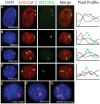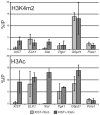Active chromatin marks are retained on X chromosomes lacking gene or repeat silencing despite XIST/Xist expression in somatic cell hybrids
- PMID: 20520737
- PMCID: PMC2875404
- DOI: 10.1371/journal.pone.0010787
Active chromatin marks are retained on X chromosomes lacking gene or repeat silencing despite XIST/Xist expression in somatic cell hybrids
Abstract
Background: X-chromosome inactivation occurs early in mammalian development and results in the inactive X chromosome acquiring numerous hallmarks of heterochromatin. While XIST is a key player in the inactivation process, the method of action of this ncRNA is yet to be determined.
Methodology/principal findings: To assess which features of heterochromatin may be directly recruited by the expression and localization of the XIST RNA we have analyzed a mouse/human somatic cell hybrid in which expression of human and mouse XIST/Xist has been induced from the active X by demethylation. Such hybrids had previously been demonstrated to disconnect XIST/Xist expression from gene silencing and we confirm maintenance of X-linked gene expression, even close to the Xist locus, despite the localized expression of mouse Xist.
Conclusions/significance: Loss of the active chromatin marks H3 acetylation and H3 lysine 4 methylation was not observed upon XIST/Xist expression, nor was there a gain of DNA methylation; thus these marks of facultative heterochromatin are not solely dependent upon Xist expression. Cot-1 holes, regions of depleted RNA hybridization with a Cot-1 probe, were observed upon Xist expression; however, these were at reduced frequency and intensity in these somatic cells. Domains of human Cot-1 transcription were observed corresponding to the human chromosomes in the somatic cell hybrids. The Cot-1 domain of the X was not reduced with the expression of XIST, which fails to localize to the human X chromosome in a mouse somatic cell background. The human inactive X in a mouse/human hybrid cell also shows delocalized XIST expression and an ongoing Cot-1 domain, despite X-linked gene silencing. These results are consistent with recent reports separating Cot-1 silencing from genic silencing, but also demonstrate repetitive element expression from an otherwise silent X chromosome in these hybrid cells.
Conflict of interest statement
Figures




Similar articles
-
Inducible XIST-dependent X-chromosome inactivation in human somatic cells is reversible.Proc Natl Acad Sci U S A. 2007 Jun 12;104(24):10104-9. doi: 10.1073/pnas.0610946104. Epub 2007 May 30. Proc Natl Acad Sci U S A. 2007. PMID: 17537922 Free PMC article.
-
A chromosomal memory triggered by Xist regulates histone methylation in X inactivation.PLoS Biol. 2004 Jul;2(7):E171. doi: 10.1371/journal.pbio.0020171. Epub 2004 Jul 13. PLoS Biol. 2004. PMID: 15252442 Free PMC article.
-
Multiple distinct domains of human XIST are required to coordinate gene silencing and subsequent heterochromatin formation.Epigenetics Chromatin. 2022 Feb 4;15(1):6. doi: 10.1186/s13072-022-00438-7. Epigenetics Chromatin. 2022. PMID: 35120578 Free PMC article.
-
Gene silencing in X-chromosome inactivation: advances in understanding facultative heterochromatin formation.Nat Rev Genet. 2011 Jul 18;12(8):542-53. doi: 10.1038/nrg3035. Nat Rev Genet. 2011. PMID: 21765457 Review.
-
XIST RNA and architecture of the inactive X chromosome: implications for the repeat genome.Cold Spring Harb Symp Quant Biol. 2010;75:345-56. doi: 10.1101/sqb.2010.75.030. Epub 2011 Mar 29. Cold Spring Harb Symp Quant Biol. 2010. PMID: 21447818 Free PMC article. Review.
Cited by
-
Impact of flanking chromosomal sequences on localization and silencing by the human non-coding RNA XIST.Genome Biol. 2015 Oct 2;16:208. doi: 10.1186/s13059-015-0774-2. Genome Biol. 2015. PMID: 26429547 Free PMC article.
-
Ordered chromatin changes and human X chromosome reactivation by cell fusion-mediated pluripotent reprogramming.Nat Commun. 2016 Aug 10;7:12354. doi: 10.1038/ncomms12354. Nat Commun. 2016. PMID: 27507283 Free PMC article.
References
-
- Heard E, Disteche CM. Dosage compensation in mammals: fine-tuning the expression of the X chromosome. Genes Dev. 2006;20:1848–1867. - PubMed
-
- Huynh KD, Lee JT. Inheritance of a pre-inactivated paternal X chromosome in early mouse embryos. Nature. 2003;426:857–862. - PubMed
-
- Wutz A, Jaenisch R. A shift from reversible to irreversible X inactivation is triggered during ES cell differentiation. Mol Cell. 2000;5:695–705. - PubMed
Publication types
MeSH terms
Substances
Grants and funding
LinkOut - more resources
Full Text Sources
Miscellaneous

